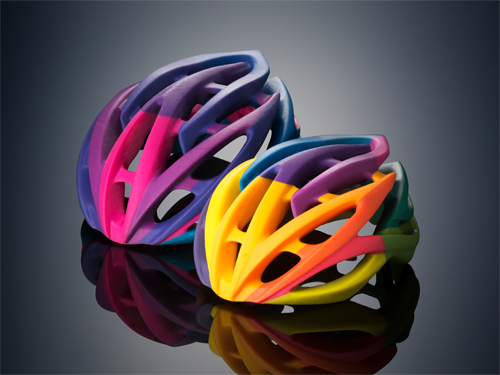The company behind the MakerBot 3D printer has launched a model that can handle multiple colors and materials in one print run. Stratasys’s new machine costs $330,000 and is very much aimed at making practical objects rather than novelty items.
Where normal 3D printers use a single stream of material, Objet500 Connex3 uses jets that can deliver three different liquefied resins. These can be combined in different proportions to create a range of rubbers and plastics with different levels of rigidity and flexibility.
The proportions can be altered mid-print, in effect creating a single printed object made up of different materials. According to Stratasys, the materials will “simulate high performance thermoplastics.”
The company gives the real example of a bicycle manufacturer that has been using the new printer to try out designs for handlebar grips, not just to gauge appearance but for practical testing. Stratasys also demonstrated prototype cycle helmets (pictured).
The printer can also deliver different colors, using the same mix of cyan, magenta and yellow that’s the basis of two-dimensional color printers. Previous multi-material 3D printers have been restricted to shades of black and white.
With particular combinations of base materials, the printer can even print a transparent plastic, meaning for example it’s possible to print a pair of spectacles as one item. Of course, the set-up doesn’t allow for prescription lenses, so it only really works for safety spectacles (in which case colors and designs aren’t usually a major issue) or novelty wear.
Indeed, the real question right now is whether the printer really does have practical uses or if it’s more a case of an impressive solution to a technical challenge.
Given the price, it’s most likely the Object500 Connex3 will be used for making prototypes at a stage of the design process that’s advanced enough for manufacturers to need to know how a product would not only look but also feel and behave, but still not advanced enough to make it financially sensible to be setting up customized production equipment such as injection molds.
The BBC makes the point that some manufacturers at this stage may be happy to use a black-and-white printer and simply use their imagination as to how the finished product will look in color.


